Kettlebells — those cast-iron cannonballs with handles you may have noticed tucked away in the corners of your health club — may look a little weird, but they can provide one of the simplest, most effective workouts around. A wide range of challenging lifting and swinging movements build both strength and cardio endurance. And, unlike many resistance devices, a kettlebell gets your whole body working at once.
Proponents of kettlebell training swear there’s no other fitness tool that can get you in shape faster with only an hour or two of use — per week. “I’ve seen thousands of success stories to back up this claim,” says Pavel Tsatsouline, a fitness instructor and nationally ranked kettlebell competitor from Russia. “Whether your goal is losing fat, building muscle, or training for powerlifting, swimming or even golf, you can perform better if you work with kettlebells.”
Invented in the 18th century, kettlebells are particularly popular in Russia, where they have long been used to train elite soldiers. By the early 1980s, kettlebell competitions began to spread across the globe, and U.S. bodybuilders started bringing the techniques to their hometown gyms.
The secret behind this Russian import’s effectiveness? Its weight is centered below the handle, so when you swing it, nearly every muscle in your body has to work hard to counteract the momentum.
“Unlike traditional free weights — which isolate certain muscle groups while the rest of your body is static — kettlebells are used in a continuous-motion, interval-style format that, research has shown, results in faster, more dramatic fitness gains,” says Michele Olson, PhD, FACSM, CSCS, an exercise scientist and strength coach at Auburn University Montgomery in Alabama.
In short, the kettlebell is a tool with tremendous work capacity; it’s designed to provide a brief but intense workout — for nearly anyone.
“Their simple design and versatility make it the ideal tool for beginners, while the cardiovascular and strength-endurance components of kettlebell training challenge even the most conditioned athletes,” says Dallas Hartwig, PT, MS, CSCS, a longtime kettlebell enthusiast and CrossFit trainer in Brunswick, Maine, who uses the tool to improve his own performance in mountain biking, competitive volleyball, climbing and skiing.
No matter what your fitness level, kettlebell workouts can increase your strength, endurance, agility and balance.
Get Into the Swing
How you use kettlebells, like any fitness tool, depends on your goals. “If you want to increase work capacity and endurance, focus on the ballistic [fast-moving] exercises such as jerks, swings and snatches, all of which keep your muscles moving and your heart rate up,” suggests Mike Mahler, a Las Vegas kettlebell instructor and creator of Mahler’s Aggressive Strength: Beginner Kettlebell Training Workshop.
For example, you can pick one exercise and do as many repetitions as possible in a 10-minute time frame — and set a goal not to put the kettlebell down for the entire 10 minutes. “In addition to getting you in great shape, this builds incredible mental toughness,” says Mahler. “If you want to build muscle as opposed to endurance, focus on compound strength exercises such as the clean and press, and do five to 10 sets of five to seven reps with one-minute breaks between sets.” (See “Clean & Press” below.)
Beginners should opt for a moderate weight (men usually start off with a 35- to 55-pound kettlebell; women usually start with between 15 and 35 pounds) and don’t increase it until you can do the moves with perfect form. Experts caution against going too light, however, because that can lead to cutting corners. “You’ll cheat, because lighter weights are easier to move — you may not make your larger leg and hip muscles work as much as they should,” says Olson. “You also won’t get a whole-body workout, and you’ll burn fewer calories,” she says.
Start with the following exercises, and ask for form tips from an expert. “While the movements appear fairly simple, their effectiveness will be maximized if you learn proper form and technique,” says Hartwig. Plus, as with any new exercise, learning the right technique will help prevent injury.
These exercises can be done individually for strength building, or in quick succession as a circuit for more cardio benefits.
Exercise 1: The Swing
What it does:
Works the shoulders, back, hips, glutes, inner thighs and hamstrings. When done in sets of 10 to 20 in quick succession (resting 30 seconds between sets), the swing is a great interval workout. “The swing improves core strength, endurance, cardio fitness and hip flexibility — something many of us are lacking,” says Missy Beaver, RKC, a kettlebell instructor in Santa Monica, Calif. (shown demonstrating the exercises below). “It also teaches you how to generate power from the hips.” This hip drive translates to other kettlebell exercises like the clean and the snatch, as well as running, jumping and even picking things up off the ground.
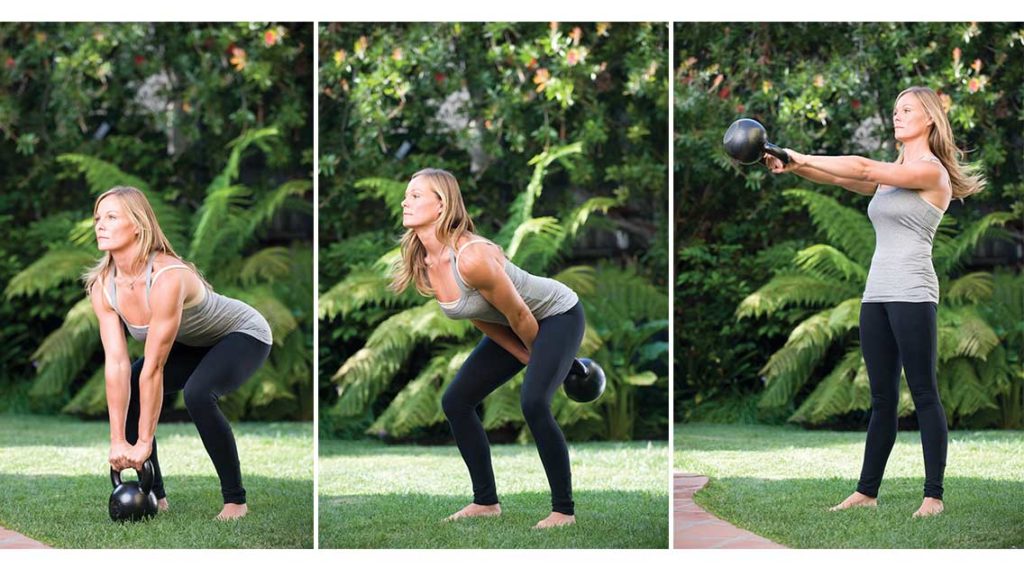 How to do it:
How to do it:
- Stand with your feet shoulder-width apart, the kettlebell centered on the floor between your feet, slightly in front of you.
- Grab the handle with both hands and squat down until your thighs are nearly parallel to the floor. Hike the kettlebell backward slightly like a football center to help get momentum going.
- Then, keeping your back flat and your arms straight, immediately stand up and thrust your hips forward, swinging the kettlebell upward until it’s at shoulder height. (The power should come from your hips and glutes — not your arms.) Imagine your wrists are made of iron and cannot bend, and keep your gaze focused forward throughout.
- As the kettlebell begins to arc back down, bend your knees and squat, swinging the kettlebell between your legs. (Don’t let it swing all the way behind you; it should stop a little behind your knees.) That’s one rep; continue swinging for 10 to 20.
- Work up to three sets of 10 to 20 reps interspersed with 30 seconds of rest.
Exercise 2: Deadlift
What it does:
Works the abs, hips, glutes, quads and hamstrings. “Runners can do dead lifts between intervals for a complete strength-cardio workout,” says Jason C. Brown, CSCS, a nationally known kettlebell instructor and owner of Kettlebell Athletics in Philadelphia. This move is a sheer strength exercise; you don’t want to do dead lifts in rapid succession because it begins and ends in a static position (unlike the swing, which is a more fluid motion). This is a great functional exercise because it mimics the squatting and lifting that’s so common in everyday activities.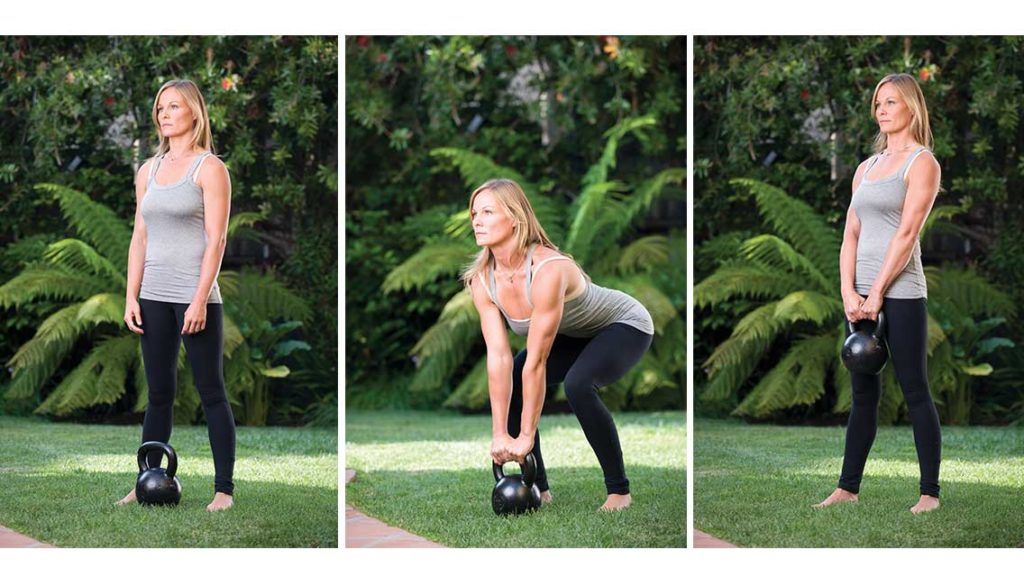 How to do it:
How to do it:
- Stand with your feet shoulder-width apart, toes turned out about 45 degrees. Place the kettlebell on the floor between your feet.
- Squat down and grab the handle with an overhand grip.
- Push your heels firmly into the floor and stand upright, keeping your arms extended downward and your back straight. Your strength and power should come from your core and lower body — not your arms.
- Keep your gaze forward as you push your butt backward and squat back down, lowering the kettlebell.
- That’s one rep; do 10, rest for a minute, and then do another set of 10, working up to five sets.
Exercise 3: Clean & Press
What it does:
Works the shoulders, back, arms, hips, glutes and hamstrings. This move can be broken down into two separate exercises — the clean pull and the overhead press — for a more strength-focused workout. But paired together fluidly, you incorporate more muscles and keep your heart rate up.
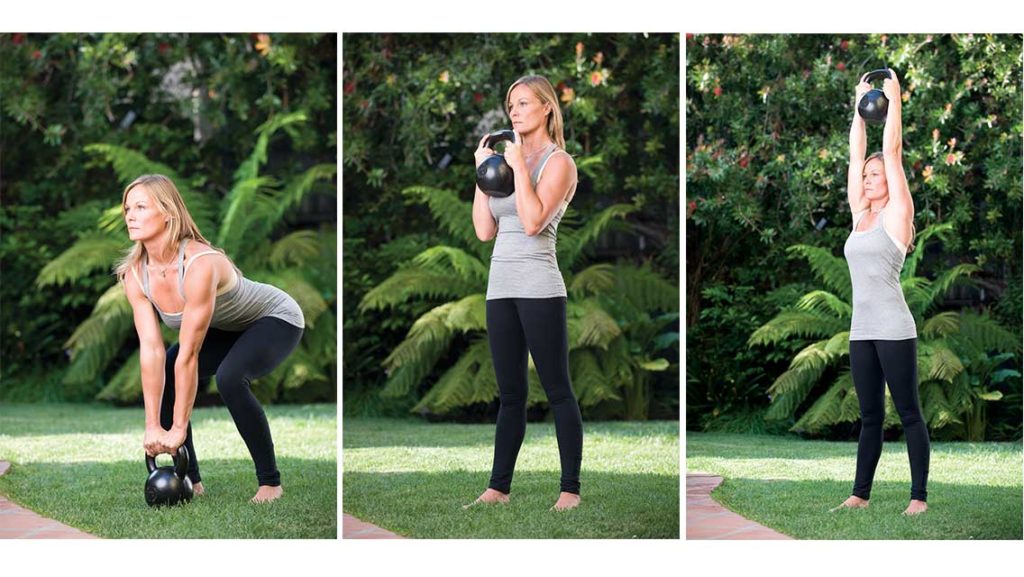
How to do it:
- Stand with your feet shoulder-width apart, toes turned out about 45 degrees. Place the kettlebell on the floor between your feet.
- Grabbing the top of the handle with your palms facing downward, explosively straighten your legs, thrust your hips forward and use a quick shoulder-shrugging action to “float” the bell upward, keeping it close to your body. (The power should come from your hips and legs — not your arms.)
- As the kettlebell nears chest height, slide your grip to the corners of the handle, bring your elbows in and down, and push the kettlebell straight overhead, straightening your elbows.
- Lower it back to your chest and assume the original grip before returning to the start position.
- That’s one rep; do 10. Work up to three sets of 10, resting 30 seconds between sets.
This article originally appeared as “Kettlebells for Everyone.”
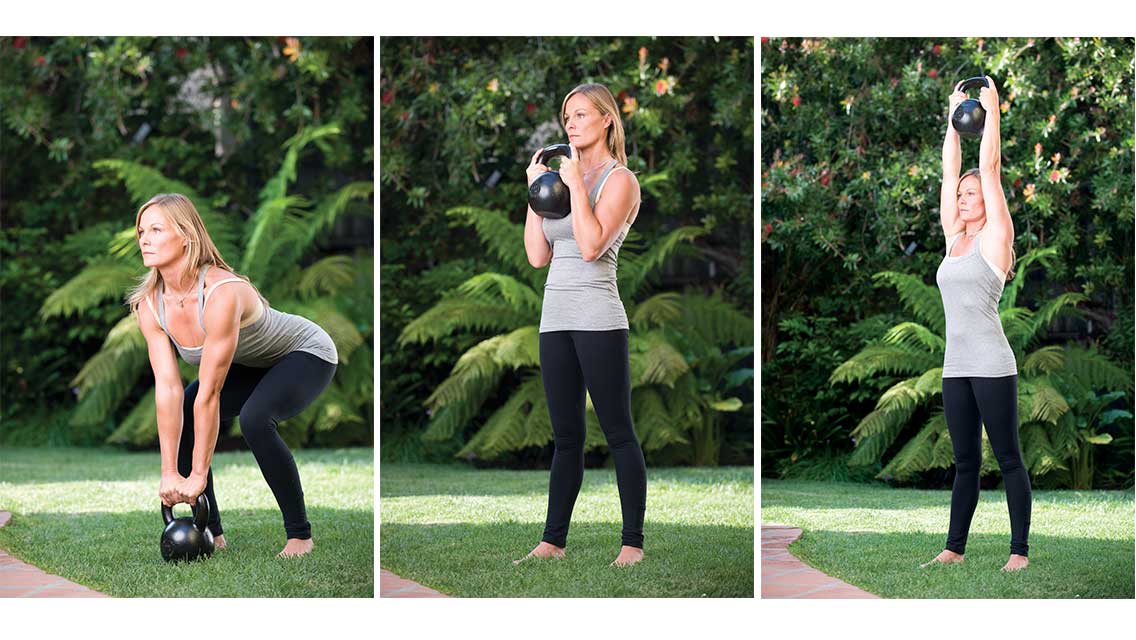
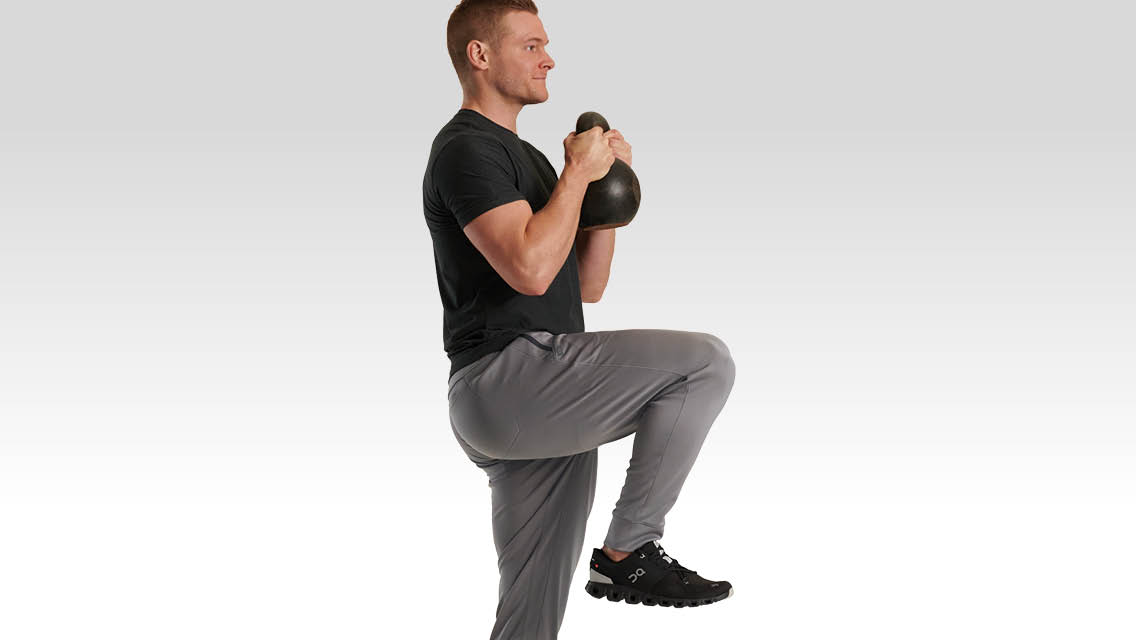


This Post Has 0 Comments